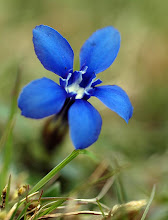


These are the fertile shoots of the notoriously invasive field horsetail Equisetum arvense, produced in spring a couple of weeks before the green photosynthetic shoots appear. When it dries out the spear-shaped point of each fertile shoot breaks up into stalked, polygonal structures with spore sacs underneath. When the spores are first released they have four arms, called elaters, with club-shaped ends wrapped tightly around the spore. The elaters immediately unwrap themselves in the dry air and assume the shape of a cross, increasing the surface area and aerial buoyancy of the spores so that they can be carried miles in the breeze.....and infest another garden. Each spore is about one twentieth of a millimetre in diameter. The short video sequence below shows the almost explosive release of tension in the elaters when they uncurl in the first few seconds after release into dry air.
































